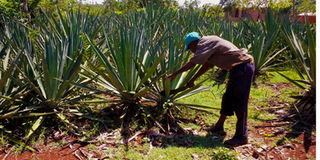‘Don’t ignore smallholder sisal growers’

What you need to know:
The call comes at a time when the practice is now taking root contributing nearly 35 per cent of the total national sisal fibre production.
Tanga. The government has been asked to stop ignoring sisal smallholder farming.
The call comes at a time when the practice is now taking root contributing nearly 35 per cent of the total national sisal fibre production.
Speaking at sisal stakeholders meeting recently in Tanga, Tanzania Sisal Board (TSB) acting director general Yunus Msika revealed that by December 2015, the sisal smallholder farmers were controlling a total of 14,690 hectares of land which is equivalent to 37 per cent of land under sisal cultivation in the country.
“We cannot ignore them anymore because they are now a force to reckon with in national production of sisal,” said Mr Msika, calling on the government and the local authorities to include sisal in sectors allocation of extension services and other services to increase their contribution.
He said that through smallholder sisal farmers, the sector expects to increase the area under cultivation by 30,000 hectares by 2022.
He argued the case of increasing support to smallholder farmers saying that because they work on small farms it was easier for them to increase productivity compared to large farmers. “Emphasis would not be out in these small areas to increase productivity and enable small farmers to increase their harvests and revenue,” Mr Msika said. He called on big farmers to help smallholder counterparts around their farms in processing, accessing extension services and markets.
He also urged local authorities to help to survey those farms and establish sisal seedling nurseries in cooperation with the Board.
He disclosed that the Board has set up plans for undertaking improved sisal farming to smallholder farmers, continuing to mobilise more people to take up sisal farming, looking for more markets and continuing to link up farmers with financial institutions that have friendly credit conditions to sisal farmers and continuing to cooperate with technological institutions to develop better implements and machines which farmers can afford.
Narrating the history of smallholder sisal farming, he said it was not entirely a new idea because the government established the Kabuku Smallholder Sisal scheme in 1960 to enable them to participate in sisal farming. The scheme did not survive for various reasons including failure to prepare villagers properly for taking part in the scheme.
The system was reintroduced in 1999 by Katani Limited and has now been expanded to other farmers not located in sisal farms previously owned by the company.




